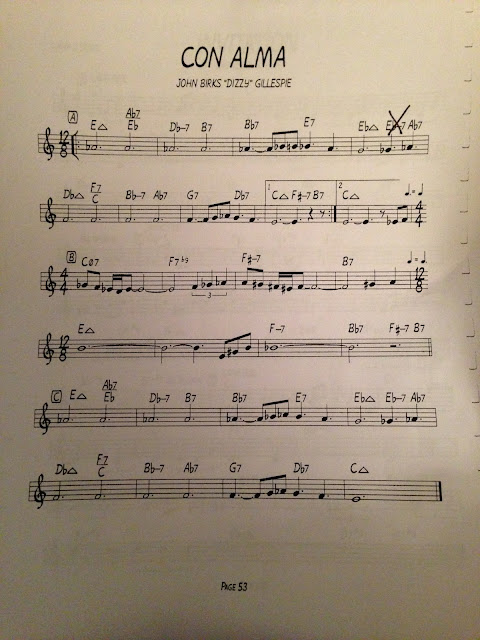Now the whole point of this is to learn the reharmonization structures he uses to make this tune sound outside on the A section. It uses intervallic lines based around augmented triads. So this is a continuation of my discovery blog on 'Playing Outside'.
Unfortunately, I can't find the actual track on Youtube so below is a live performance so it will not match the transcription. After listening to this particular one, he's sticking to the same tonality and I can hear the same structure but he's playing it completely differently from the original record (as I would expect).
Anyway, the starting point is the leadsheet below. This sounds like what the bass player was playing.
Now this is an interesting version to figure out because if you listen to the original recording, you can hear that it sounds pretty 'out' on the A section.
Specifically, AP reharmonized this with Maj7#5, Dom 7 with #5 b9 and #11 in the A section. The intervals used are primarily triad shapes. So they're made to imply harmony.
The B section is played completely inside the standard harmony as far as I could hear (I've transcribed the first chorus only). There are only two chords per bar so all extra chords beyond 2 are not played.
Transcription is based on this track: https://www.box.com/s/zjzfc3r5o7jsbgztrug4
Partial Transcription. First A section of solo.
As the transcription shows, all the Maj7 chords have a #5. The first EMaj7 has a #5 but before the first chord is played. The EMaj7 is implied I think since no chords are played on the pickup. Alterations on the dominants vary. Sometimes only a #5, and at the most b9, #11, and #5. The solo is heavy on triad shapes, including Augmented triads. I'm not sure if I positioned the triplets correctly on the bar line but it's close enough for analysis purposes. I'm just not good at notating rhythm.
As a practice strategy here, clearly one needs to visualize the various dominant alterations as triad shapes. To be able to pull this at will like below requires complete mastery of 12 tones for each chord.
-----
This whole Con Alma transcription project revealed some new shapes to me, like arpeggiations within a whole tone scale. When I got familiar with that, going a little out on Con Alma isn't that hard at all. The issue is how not to overdo it. I got a lot of ideas here. By looking for triad shapes in the WT scale, I could really have only one 'out' note. Either a #11 or a #5.
Now AP isn't just using a WT scale. Lots of triad upper structures. But if I'm going to have a take on what I learned here, it's that I shouldn't abuse the 'color'.
One could play this tune completely inside at moments than subtly switch to what AP is doing. And thus it really offers some fun opportunities for playing with tension/release and surprise the audience a little.
I guess these realizations are the payback for the hard transcription work.


No comments:
Post a Comment